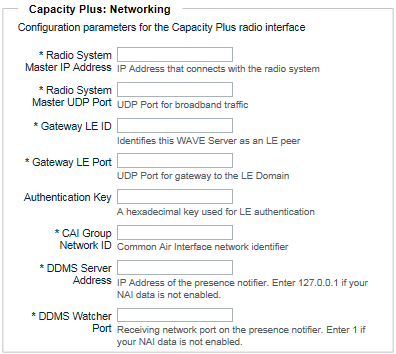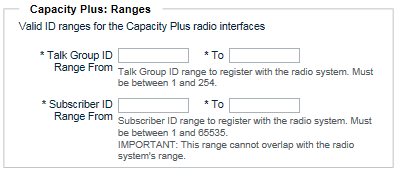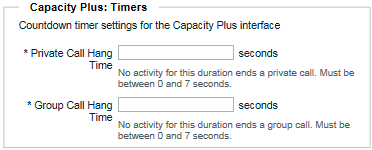|
1.
|
|
2.
|
|
3.
|
|
A.
|
In Radio System Master IP Address, enter the IP address connecting to the Capacity Plus radio system. In the Capacity Plus repeater, this address is labeled “Master IP.”
|
|
B.
|
In Radio System Master UDP Port, enter the UDP port for broadband traffic. In the Capacity Plus repeater, this address is labeled “Master UDP Port.”
|
|
C.
|
In Gateway LE ID, enter the ID used to identify the WAVE 3000 Server to Capacity Plus as an LE (Link Establishment) peer. In general, this is a unique number that does not occur in the radio system.
|
|
D.
|
In Gateway LE Port, enter the UDP port that serves as the gateway to the LE (Link Establishment) domain. The WAVE 3000 Server uses this port to send and receive audio and keepalive messages with the Capacity Plus radio system.
|
|
E.
|
In Authentication Key, enter the LE authentication key (if used). Leave blank if your Capacity Plus system is not configured to require an authentication key.
|
|
F.
|
In CAI Group Network ID, enter the Common Air Interface network identifier. In the Capacity Plus repeater, this ID is labeled “CAI Group Network.”
|
|
G.
|
In DDMS Server Address, enter the IP address of the Capacity Plus presence notifier. This is only required if NAI Data is enabled on the radio system. If your Capacity Plus system does not use NAI Data, then enter 127.0.0.1 for the IP address.
|
|
H.
|
In DDMS Watch Port, enter the receiving network port for the Capacity Plus presence notifier. This is only required if NAI Data is enabled on the radio system. If your Capacity Plus system does not use NAI Data, then use 1 for the port.
|
|
4.
|
|
A.
|
In Talk Group ID, enter the start and end range of Talk Group IDs to register with the Capacity Plus radio system. All specified IDs in the range will attempt to register with the radio system. This range includes both radio and WAVE IDs. The range you specify must include the Talk Group IDs in the radio system. The WAVE 3000 Server will prevent you from creating Talk Groups outside this range. Talk Groups you create for broadband-only do not include a Talk Group ID. This is explained further when you create a Talk Group.
|
|
B.
|
In Subscriber ID, enter the start and end ranges of Subscriber IDs for broadband users only. This range must not include radio users. The WAVE 3000 Server prevents you from creating radio users inside the specified range. The WAVE 3000 Server prevents you from creating broadband users outside the specified range. All specified IDs in the range attempt to register with the radio system.
|
|
5.
|
|
A.
|
In Private Call Hang Time, enter the amount of time in seconds required to terminate a Private Call. This value should match the Private Call Hang Timer specified in the Capacity Plus system. Each Private Call transmission between a radio and a broadband client resets this timer. Once the timer expires, the Private Call session is terminated and all resources are freed.
|
|
B.
|
In Group Call Hang Time, enter the amount of time in seconds required to terminate a Group Call. When this timer is exceeded, the Group Call session is terminated and all resources are freed. This only applies to connections between radios and broadband clients. New Group Call resources are immediately acquired when a Group Call transmission is made between a radio and a broadband client. For best results, match the corresponding value in the Capacity Plus system.
|
|
6.
|
|
7.
|
|
8.
|
In the Anonymous User section, enter a value to identify anonymous WAVE users to the Capacity Plus Radio system. This field is used to identify WAVE users without Subscriber IDs. Capacity Plus radio system administrators should use the specified ID in this field to identify an anonymous WAVE user to radio users.
 |
|
9.
|
In the Time Zone section, select the time zone for your WAVE 3000 Server.
 The time zone you select is applied to the WAVE 3000 logs. |
|
10.
|
Click the Save button.
|





